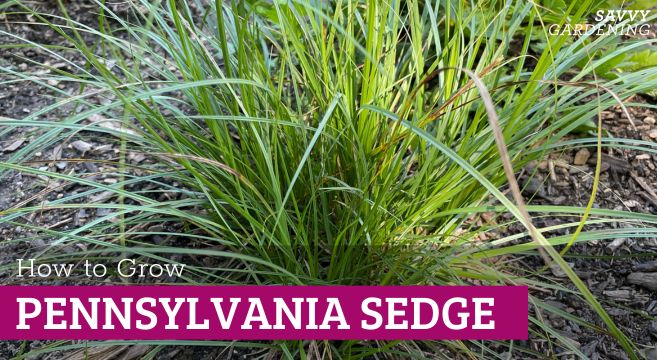This post may contain affiliate links. If you make a purchase through links on our site, we may earn a commission.
As my collection of native plants grows, I’m developing various favorites. One of them is Pennsylvania sedge (Carex pensylvanica), a sweet, compact native perennial that offers a wispy texture to a garden, is a host plant for butterflies and moths, and can be used to replace a traditional lawn. In this article, I’m going to share some growing tips, as well as ideas on where to plant Pennsylvania sedge.
Where does Pennsylvania sedge grow in North America?
Although its name suggests it is solely native to one state, Pennsylvania sedge is native to various parts of North America, predominantly in the east and in some central states. It is hardy down to USDA hardiness zone 3, which are areas that see temperatures dip between -40°F and -30°F (-40°C to -34.4°C). In Canada, that native range reaches across the southern parts of the country, from British Columbia and Alberta through Saskatchewan, Manitoba, Ontario, Quebec, New Brunswick, and Nova Scotia. In the United States, the plant covers a vast area—all the states in the Northeast, as well as parts of the Midwest and a small handful in the South.

Where should you plant Carex pensylvanica?
Also called oak sedge because it’s often found growing under oak trees, other common names include early sedge and yellow sedge. This compact little plant really will fit into any empty space in the garden. The wispy nature of Pennsylvania sedge adds texture and complements other plants around it. The plant does spread by rhizomes, so there may be some work involved to contain it. If you happen to find a little clump coming up near the plant, simply dig it up and transplant it to another part of the garden.
Even though it has a little bit of height (it grows to be about six to 12 inches/15 to 30 cm tall), Pennsylvania sedge can be planted as a groundcover or lawn, which I explain further below. It doesn’t love being walked on, so plant it in a low- or no-traffic area. And if you’re looking for shade perennials, this is a worthy option.
If you’d prefer more of a grouping among other plants rather than a full lawn, plant your sedges in odd-numbered arrangements—three, five, seven, etc. Keep their short stature in mind so that you don’t inadvertently hide them among taller perennials.

Pennsylvania sedge is also a great pick for plant borders as it’s low-growing and easy to contain. I like the look of it tumbling over a stone retaining wall or garden edge.
Planting Pennsylvania sedge
Check out your local nursery or native plant retailer when you’re looking to buy Pennsylvania sedge plants. It’s a very unfussy little plant. Pennsylvania sedge generally grows in dry woodland areas and thickets, and doesn’t mind a bit of sun (but will tolerate full sun) or full shade. A bonus? It’s deer resistant. And while it’s drought tolerant and will thrive in dry soils that are sandy or loamy, it also doesn’t mind moist soils, which many other sedges prefer. In fact, it is often a suggested option in rain garden plant lists because of its ability to survive in moist soils. Pennsylvania sedge has a thick root system that helps to filter rainwater.

Plant your new native plant as you would any other perennial. Dig a hole to accommodate the roots. Pull the plant from its pot and place it in the hole. Cover with soil, and water thoroughly. While Carex pensylvanica is drought tolerant, it may need to be watered regularly until it’s established itself in the garden.
Even though it’s a smaller plant, Pennsylvania sedge adds wildlife value to a garden, as it provides cover for migratory birds, as well as habitat. It’s also an important host plant for butterflies and moths.
Creating a Pennsylvania sedge lawn
As traditional lawns become more recognized for being unsustainable and relics of a bygone era, there are lots of ideas for alternatives to the common Kentucky bluegrass, ryegrass, and fine fescue combo of which turf grass mixes are commonly comprised. In Gardening Your Front Yard, I explore some lawn alternatives, including eco-friendlier fescues. I even planted up a sedum “lawn” for one of my projects. However, “sedgescaping” is something I would have included had I discovered the catchy buzzword sooner.

Planting a lawn from Pennsylvania sedge plants is a great way to create a carpet of green without the maintenance, especially in shady areas. It doesn’t look untidy, it just has a nice soft-looking texture to it. A bonus? You don’t have to mow it. When the plants all fill in together as they mature, the way the leaves arch and fall resembles soft waves.
Other native plants to add to your garden
Pin this to your native plants board.




I really want to grow Pennsylvania or Appalachian Sedge. I have been searching for a seed source for greater than 3 years. I have a 30 ft by 4 foot bed. Buying plans from a nursery is not financially feasible. Any idea where I can purchase seeds? Thanks.
Hi Linda,
There seems to be a few places that sell seed for these two sedges – Prairie Moon Nursery and Prairie Nursery are a couple I found.
If you want to grow Pennsylvania sedge from seed, you will have to cold stratify the seeds, or plant them outdoors in the fall. They need cold to germinate.